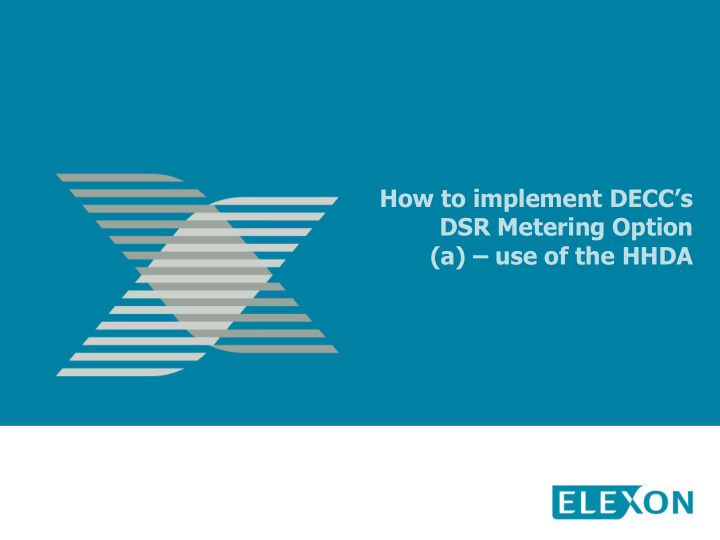



How to implement DECC’s DSR Metering Option (a) – use of the HHDA
Agenda Item Timing Lead Introductions 10.00 (5 min) All Objectives, scope and 10.05 (25 min) ELEXON approach of Workshop Discussions 10.30 (1.5 hrs) All (working) Lunch 12.00 (30 min) All Discussions 12.30 (1.5 hrs) All Break 14.00 (15 min) All Wrap up and Next 14.15 (30 min) ELEXON Steps AOB 14.45 (15 min) All 1
What is the context for this metering option? The Capacity Market seeks to provide a “regular retainer payment • to reliable forms of capacity (both demand and supply side), in return for such capacity being available when electricity supply is squeezed. This will reduce the threat of blackouts due to insufficient capacity on the system .” Capacity Providers have four metering options to provide data to • the Settlement Agent: a) HHDA provides SMRS registered metered data b) Bespoke (private wire) metering (policy in development) c) Additional BMUs d) STOR metering 2
DECC Policy EMR Consultation on Proposals for Implementation: • DSR metering option (a) 579. The DSR capacity provider must notify the data collector (appointed by the supplier) to pass the half hourly, non-aggregated BSC metered data for the relevant CMU component (and related meters on the same site if appropriate) to the settlement agent. This option is for either DSR, embedded generation that exports electricity to the network, or embedded generation which has a separate BSC meter. Following DECC’s workshop in November 13: • “The DSR capacity provider must notify its Supplier, who will instruct its Half Hourly Data Aggregator to pass the half hourly, non-aggregated BSC metered data adjusted for Line Losses for the relevant CMU component to the settlement agent .” 3
Objectives of Workgroup “Consider if the ‘ strawman DTC changes’ adequately deliver DECC’s policy, and if not, recommend a set of BSCP and DTC changes that do deliver DECC’s policy.” “Consider implementation approach and how best to meet DECC’s implementation timescales.” 4
Scope In scope: • Strawman DTC changes document • DTC data flows • BSCP processes • BSC changes that do not impact DECC’s policy • Implementation considerations • Out of scope: • Policy – today is about the best way to do it • BSC changes that impact DECC’s policy • Use of the DTN to transmit data to the CM Settlement Agent • Strawman discussed at DECC’s November workshop • 5
Approach and Next Steps Document Workgroup changes meeting to Comments directed by discuss items received from Secretary of within scope group State. • 26 March • 9 April • Jul / Aug 2014 Discussions Draft necessary HHDA metering from meetings document option with clear changes implemented solution • 16 April • March 2015 identified circulated to group for review • 2 April 6
Strawman Proposal Key TBC EMR Entity Via DTN BSC Entity Out of scope Request to submit data Flagged MPAN Instruction to flag via HHDA for CM consumption data relevant MPANs Settlement 4. CM 2. 1. Capacity 3. HHDA Settlement Supplier(s) Provider Agent Acceptance/rejection of instruction Notification of MPANs needed for CM Settlement 7
Workshop Format For each entity we will consider: • 3. What possible fixes are there for the possible problems? 4. What changes do we need to make to the strawman? For each question we will spend 10 minutes as a group and 10 • minutes as a room thinking and making notes on that question 8
- considering purely what information is available, what are the facts? What items from the strawman are needed? • What information does the Supplier need to send to the HHDA? • When does the information need to be sent? • What documents are impacted? • 9
Suppliers • Black - logic applied to identifying reasons to be cautious and conservative What difficulties could the Supplier face? • • What information is missing/ redundant from the proposed flow? 10
– Alternatives, possibilities, new ideas, new concepts, improvements, options e address the items from the black hat? How can we address the items from the black hat? • 11
– Thinking about thinking, next steps, summarising, clarifying, precision, overview o • Where are we now? • What changes do we need to make to the proposal? 12
- considering purely what information is available, what are the facts? What items from the strawman are needed? • What information does the HHDA need to receive? • What information does the HHDA need to send? • When is the information needed? • What documents are impacted? • 13
HHDA • Black - logic applied to identifying reasons to be cautious and conservative - What difficulties could the HHDA face? - What information is missing/ redundant from the proposed flow 14
– Alternatives, possibilities, new ideas, new concepts, improvements, options e address the items from the black hat? How can we address the items from the black hat? • 15
– Thinking about thinking, next steps, summarising, clarifying, precision, overview o • Where are we now? • What changes do we need to make to the proposal? 16
1. Capacity Provider What information will Suppliers need from Capacity Providers? • How could this be provided? • When should this be provided? • 17
4. Capacity Market Settlement Agent How should the Settlement Agent handle missing or unexpected • data from HHDAs? 18
Next steps What happens next? • 19
Recommend
More recommend